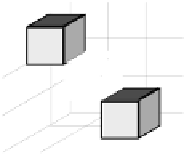Image Processing Reference
In-Depth Information
+/ 8
?
-
8
?
+
Fig. 6.6.
The starting point condition of Algorithm 6.4.
tion of the tracing
, and the sign and the amount of the curvature at the
voxel P satisfy a given condition.
Algorithm 6.4 (Ridge line extraction tracing type).
[STEP 1]
Scan the whole of an input image by the raster scan and start
the procedure at the next voxel after the current voxel if it has not been
traced yet.
Go to
[STEP 3]
, if all adjacent voxel pairs in the 26-neighborhood of a
voxel P satisfy the starting condition.
Go to
[STEP 2]
, if 12 of 13 adjacent voxel pairs satisfy the starting
condition.
Terminate tracing when the scan finishes.
[STEP 2]
Select as tracing direction the direction toward one of the voxels
of the adjacent voxel pair that does not fulfill the
starting point condition
from the trace starting point. Then start the actual tracing procedure.
Go to
[STEP 4]
,ifthe
tracing procedure
terminates.
[STEP 3]
If there exists a voxel P
that satisfies the continuity condition
among voxels adjacent to a starting point, begin the
tracing procedure
in
the direction connecting the above voxel P
and the starting point.
Go to
[STEP 4]
,ifthe
tracing procedure
terminates.
Go to
[STEP 2]
unless the direction satisfying the
continuity condition
exists.
[STEP 4]
Go back to the
starting point
and begin
tracing procedure
again,
along the tracing direction rotated by
180
degrees (in the direction oppo-
site to the previous one).
[
Tracing procedure
]
Prepare an image
F
W
(work area; all voxels are initialized
by
0
) of the same size as an input image.
[STEP I]
Move a current voxel by one voxel in the direction of tracing. If
the
continuity condition
is satisfied at the current voxel after the above
one-voxel shift, then write value
1
into the voxel of the image
F
W
corre-
sponding to the current voxel and repeat
[STEP I]
.







Search WWH ::

Custom Search